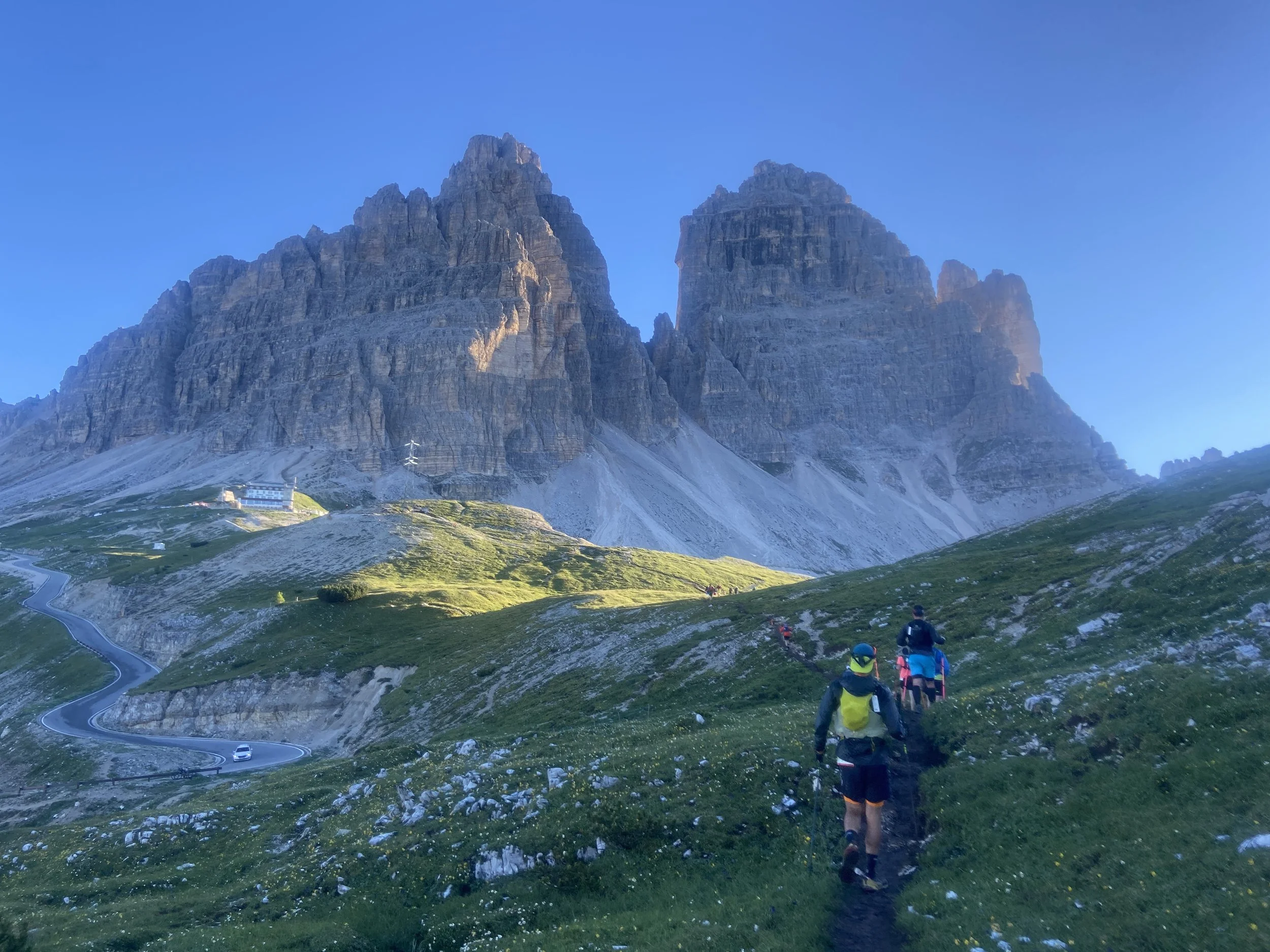Trail Running For Beginners
TRAIL RUNNNG FOR BEGINNERS
Our complete beginner’s guide gives advice on how to trail run, what type of gear you will need, tips on how to successfully run uphill, tackle the downhills, as well as how to access your local trail heads wherever in the world you live!
We live, breathe and work in the trail running world - how lucky are we!
Over the years we have built a wealth of knowledge and experience about all things trail running.
We get asked a lot of questions ranging from all aspects of the sport, and we thought it would be a great idea to share our beginner’s guide that covers everything you’ll need to know; from how to start finding local trails from your doorstep, tips on technique, some of the best running gear, nutrition and safety.
We kick start this guide by answering the basics about how to trail run, what is it and whether is it harder than road running, moving onto more technical discussional points on pace and technique.
WHAT IS TRAIL RUNNING?
Trail Running in our eyes is anything off-road, this constitutes a footpath, bridleway or anything dirty which is undulating and provides a route which preferably involves a bit of elevation gain or loss along the way. Forests, meadows, fields, river banks, mountains, fells, seashores, and hills, these are all trails and many of which will be waiting within just a few minutes of your front door.
IS TRAIL RUNNING HARDER THAN ROAD RUNNING?
If you are brand new to trails you may be wondering how it will compare to hitting the harder pavements around your regular routes.
In short, it’s a definite yes that it is harder than regular road running, but we’ll explain this in a little more detail.
Firstly, you’ll notice that the changing terrain (and changing seasons for that fact) of trail running will affect your overall pace. Your route may start out flat, but add in a slight gradient over rough terrain that weaves, climbs and flows downhill and you’ll soon notice that your comparative effort and the pace are totally different to a road run.
We also mention seasons as the same trail is not the same on a hot summer’s day, as it is on a wet winter day (especially if like us you’re from the UK). Wet, slippery conditions add another layer to the experience often requiring harder effort and more focus.
It’s also important to point out that many people look to get into trail running to help their mental health. Leaving the PRs and crowds of road running behind. Seeking the joy of trail running is a journey, with the added bonus of having an exploration element thrown into a workout, running beautiful trails and adapting to a fast and changing environment can be so wonderfully fulfilling.
How to trail run: Top tips and the basics you need to know
Through this section, we consider some basics on how to pace yourself correctly on trails, as well as how to tackle those uphills (which we all seem to hate), as well as downhill running and technique.
TRAIL RUNNING TECHNIQUE
The biggest joy of trail running is that it is so easy to get started and trails can be found everywhere. For the beginner trail runner starting in the countryside, the footpath is the ideal place to start, as you can run almost the same as you would if running on a road. Over time you will build up your running fitness, as well as your endurance and will help you stay healthy and injury-free.
Over time when you graduate to running in hillier and more mountainous areas, we need to start considering running techniques in greater detail. The underfoot terrain can change dramatically, with the loose ground, stones, tree roots, and hard uphill and steep downhill sections all considered hazards to think about. On longer trail runs this can become more taxing on your mental and physical strength as you spend longer focusing on the changing terrain around you, whilst experiencing the harder physical toll it takes on your body.
If you take it steadily, you will gradually become accustomed to this changing terrain, adapting to its changes and being able to withstand the endurance elements associated with trail running as your strength and stamina improve.
PACING
Road running is immersed in pace per mile and split times, it can be an intimidating battleground to navigate if you are brand new to the running sport.
The wonderful news is that trail running is not associated with any of these; it’s you against adventure, you decide the rules of play.
When it comes to running on trails it is important to stress that your miles per minute will be greatly slower than your miles on the road. As a guideline comparison, an 8 – 10-minute mile road runner will roughly cover the same ground on trails 1 – 2 minutes more slowly depending on the route, this could even be slower. What that means is to forget about the pressures and expectations, focus on you dictating your own pace and enjoy the flow of the trail. An important message to remember is that it is encouraged to walk all of the ups, as well as all of the downs if you are not as confident in your footing. Jog all of the flat bits and enjoy your surroundings.
HOW TO TACKLE THOSE HILLS
Learn to embrace those hills, they are not as horrible as they make out to be.
Imagine the scene, you are out trail running feeling amazing and then out of nowhere a steep hill presents itself in front of you….damn! That’s just ruined your flow…and it looks hard as hell to get to the top.
The biggest secret in the trail running world…walk! Walk that thing if you need to, depending on gradient it’s often way better for you to tackle the hill by walking up it, allowing some of your muscles to recover until you start running again once you’ve hit the top.
For the masochists out there (or depending on what type of training day it is) you may want to run up it. If that’s the case:
Shorten your stride length
Keep light and nimble
Take your foot off the gas and get into an easy rhythm that keeps you ticking over
Use both of your arms to drive yourself up the hill
HOW TO RUN DOWNHILL
The best bit of trail running, finding a beautiful downhill section where you can let yourself go and cover ground quicker and easier than you’d like to, BUT there are a few pointers on how to make the most running downhills:
Lean forward and go with the flow. Gravity wants to pull you downhill, avoid the urge to lean back (it’s like putting on your handbrake), give yourself a bit of courage to lean forward and go faster
Use those arms for balance. Get those arms spread out and it will be notably helpful for balancing your descent along the trail
Try not to overstride. Keeping your stride length short keeps you in check, and able to respond to obstacles along the way
How To Avoid Falling Over When Trail Running
This is probably the single most concern about trail running, but there are a few easy pointers to help you at ease when hitting the trail.
Firstly, just slow down - try not to worry about your pace and focus on the enjoyment. Give yourself time to adapt and improve trail running.
Keep focussed on what you are doing by looking a few metres in front of you with the occasional glance further up on the trail. You are looking out for potential obstacles and trip hazards so that you are able to react and avoid falling over.
Finally, take smaller steps as you run on the trail. Keeping your feet closer to your centre point of gravity will reduce to likely hood of slipping over.
How To Find TRAILS NEAR YOU
Regardless of where you live you’ll be surprised by how many local footpaths, bridleways and trails are within walking distance of your front door.
The best way to find trails to run is by downloading the Strava or Suunto app onto your phone and using the ‘route mapping’ software which is inbuilt within the app. Particularly with Strava the ‘heat maps’ it displays gives local usage of other recreational runners and cyclists which gauges how popular a route is.
With the software, you are easily able to build your own routes with indications on mileage and total ascent built into the route. You’ll be surprised even in urban areas how man
How To KEEP SAFE TRAIL RUNNING
Do remember that trail running is an adventure, it’s wild and away from the paved pedestrian roads and vehicles, and you may end up running remote routes away from access or other people.
With that in mind, consider your safety and the risk of injury associated with the route you are intending to run. Plan your route in advance, taking the appropriate kit with you based on the weather conditions and the time of day you intend to run. It’s always worth carrying a fully-charged mobile phone with you in case you injure yourself and require assistance. Also. it's worth telling somebody where you are planning to go and how long you will be out for.
Likely, you won’t have to use any of it, but being prepared is always best practice and will give you the confidence to go further for longer and your experience of trail running continues to grow.




